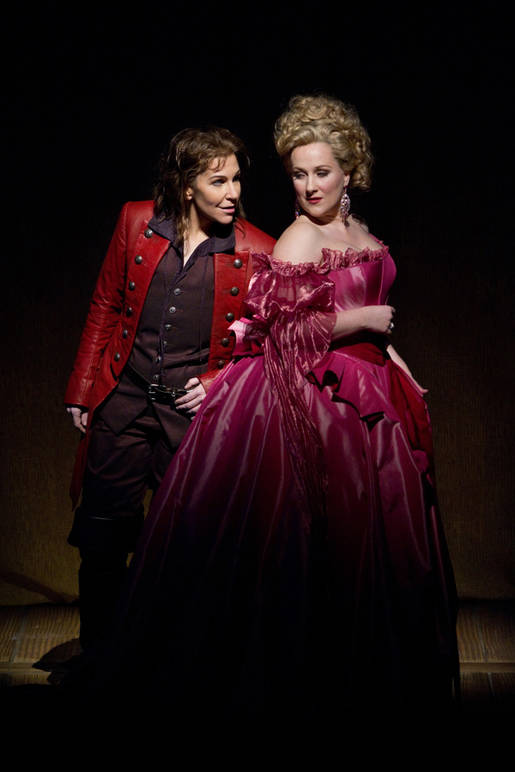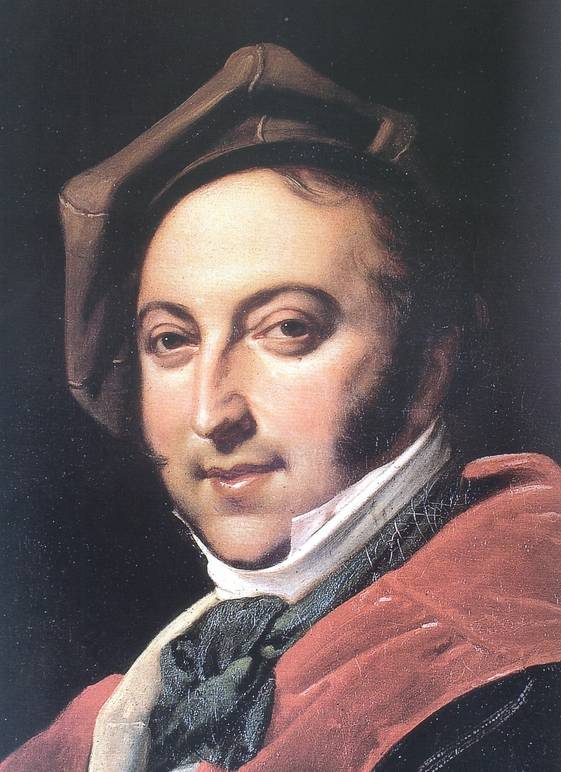The Good Stuff. Mezzo-soprano Joyce DiDonato Stars at the Met and at NYU
On March 24, the Metropolitan Opera staged, for the first time, Le Comte Ory, Rossini's only French comic opera, in a production directed by Bartlett Sher, featuring Juan Diego Flórez in the title role, Diana Damrau as Countess Adèle, and Joyce DiDonato as Isolier, the Count's page. Maurizio Benini led from the pit.
In the story, Ory, a womanizer, tries to take advantage of the Crusades to seduce the many lonely wives who have been left behind by the soldiers fighting in the Holy Land. Dressed first as a hermit and then as a nun, the Count plots to win over Countess Adèle, who lives secluded in her castle, but runs up against his young page, Isolier, who is also in love with her.
In this production, Isolier, sung by DiDonato, hops on stage half-way through Act I in leather traveling clothes and boots, with a long flow of curly brunette hair, fueling the remainder of the performance with romance and true passion.
Born and raised in Kansas, DiDonato studied at Wichita State University, where she became interested in opera. She began winning important competitions during the 1990s and in the course of the last decade quickly ascended to the Olympus of stars of the bel canto repertoire and beyond, debuting at New York City Opera in 2003 in Jake Heggie's Dead Man Walking. Her Metropolitan Opera debut took place in the 2005-2006 season as Cherubino in Le nozze di Figaro, and since then she has become a frequent performer on the main New York operatic stage.
On March 30, she shared the small stage of New York
University's Casa Italiana Zerilli-Marimò with music expert Fred Plotkin in his ongoing series, Adventures in Italian Opera with Fred Plotkin. In front of a full house the two participants, who had never met before, discussed many aspects of the world of opera, and the mezzo-soprano gave a demonstration of her solid knowledge, attention to detail, respect for the art form, personal modesty, and terrific sense of humor, which greatly entertained the public.
Dressed in pants and leather boots – almost identical to Isolier's garb in the current Met production – the singer began by speaking about the current musical scene in Kansas and the influence that that state had on her attitude towards her work:
“One of the things that has served me really well growing up in the Midwest is that I'm not afraid of work and I'm very aware that it takes a lot of people to produce something. I've never shied away from the workload involved in starting a career and building a career, and hopefully maintaining a career at a high level.”
The singer explained that today we are more specific about voice types, but that actually a mezzo-soprano is a voice type that can fill the gaps, touching very low notes as well as reaching well into the soprano range.
“I can't stay in [the soprano] tessitura; it is where I am not most comfortable. I can go up there with a certain degree of success, but I can't stay there. For example, I would never sing Donna Anna [in Don Giovanni], but I have sung Donna Elvira rather successfully in the transposed version of [the aria] “Mi tradì,” which Mozart actually did, taking it down a half step.”
The audience was particularly fascinated when the diva gave a demonstration of the work involved in figuring out the characterization of a role. “It's in the music. All the cues for interpretation are mostly in the score,” she explained, pointing out the difference between singing a role in a Haendel opera – where there is almost no notation for the singers beyond the bare notes – and performing twentieth-century operas, in which composers tend to mark everything they require of the singer. She added that in performing Rossini, there is usually more than one version to choose from, since in different cities he would adapt his works to particular voices. “That's the great freedom of this kind of music. I get to put my signature on it.”
A few nights earlier, DiDonato had sung a Rossini aria in front of a Broadway crowd, trying to transmit the composer's audacity in the vocal line. The public went wild. “My mantra is that if you give people the good stuff, they get it.”
A brief discussion followed about the upcoming run of Strauss' Ariadne auf Naxos, which will feature DiDonato in the first act as the Composer, alongside Lithuanian soprano Violeta Urmana in the title role, a rare occasion in which such different voices can come together. Urmana will be Fred Plotkin's next guest at Casa Italiana, on April 13.
The audience was able to listen to a few examples of Ms. DiDonato's repertoire, especially from her Diva/Divo album (EMI/Virgin Classics), a collection of arias featuring different characters, both male and female, one of the peculiarities of the mezzo-soprano repertoire. While commenting on her performance as Romeo in Bellini's Romeo e Giulietta, Plotkin mentioned having seen her perform the role in Paris opposite a seven-month pregnant Anna Netrebko. “I'm really good at those pants roles,” joked DiDonato.
And a pants role is what DiDonato is performing now at the Met: a role that, character-wise, lies halfway between Romeo and Cherubino. Like Cherubino, Isolier is a page, but a slightly older one, who not only longs for a woman but is loved back by her.
Rossini wrote his second-last opera over a fifteen-day
period in 1828, at age thirty-six, one year before Guillaume Tell and his subsequent retirement from the world of opera. By then he had thirty-nine titles behind him and was easily the most popular composer in the genre. At the time, he was living in Paris, having been commissioned by one of his fans - King Charles X - to write five operas a year as music director of the Théâtre des Italiens.
However, Ory premiered at the Opéra in Paris, which usually staged serious operas. Although the work is a farce, the music follows the more canonical alternation of long set-pieces and accompanied recitatives, unlike the shorter pieces and spoken dialogue of the opéra comique genre. As frequently happened with Rossini's works, a large amount of the score was taken from a previous opera, in this case Il viaggio a Reims, composed three years earlier for the coronation of Charles X.
The opera was a huge success with both public and critics, and Hector Berlioz declared that the second act love trio was Rossini's masterpiece. The trio involves the tenor, dressed as a woman, seducing the mezzo-soprano who is playing a young man dressed as the soprano, while the real soprano remains hidden.
The current Met production, like the world premiere 183 years ago, has been a success. The singing is outstanding, with the three lead singers tackling their roles with agility, humor, and flawless virtuosity. Benini and the Met orchestra are terrific as usual, but the production seems ready to fall apart under the weight of its tastelessness. Bartlett Sher is a remarkable director whose two previous productions at the Met – Rossini's Il barbiere di Siviglia and Offenbach's Les Contes d'Hoffmann – were clever and never felt overdone.
Ory, on the other hand, has ups and downs. The concept behind the production is meta-theatrical, with a small, commedia dell'arte-style, candle-lit wooden stage placed in the middle of the real stage, and with the performers entering and exiting in full view, offering staged glimpses of back-stage frolics and vintage stage management, such as wind and thunder machines and hanging candelabras. This is all reminiscent of Giorgio Strehler's classic production of Goldoni's Arlecchino servitore di due padroni with the Piccolo Teatro di Milano, but it completely lacks Strehler's taste in never carrying the farce too far.
Sher never misses the opportunity to deliver some sort of joke, whether it is someone being knocked over or grabbed in the private parts. None of these situations would, by itself, flunk the production, but the overload kills it. The sets, by Michael Yeargan, are well done and fit in beautifully with Sher's concept, and, of course, it is the result that counts: the musical quality is outstanding and the audience loves the whole thing.






































i-Italy
Facebook
Google+
This work may not be reproduced, in whole or in part, without prior written permission.
Questo lavoro non può essere riprodotto, in tutto o in parte, senza permesso scritto.